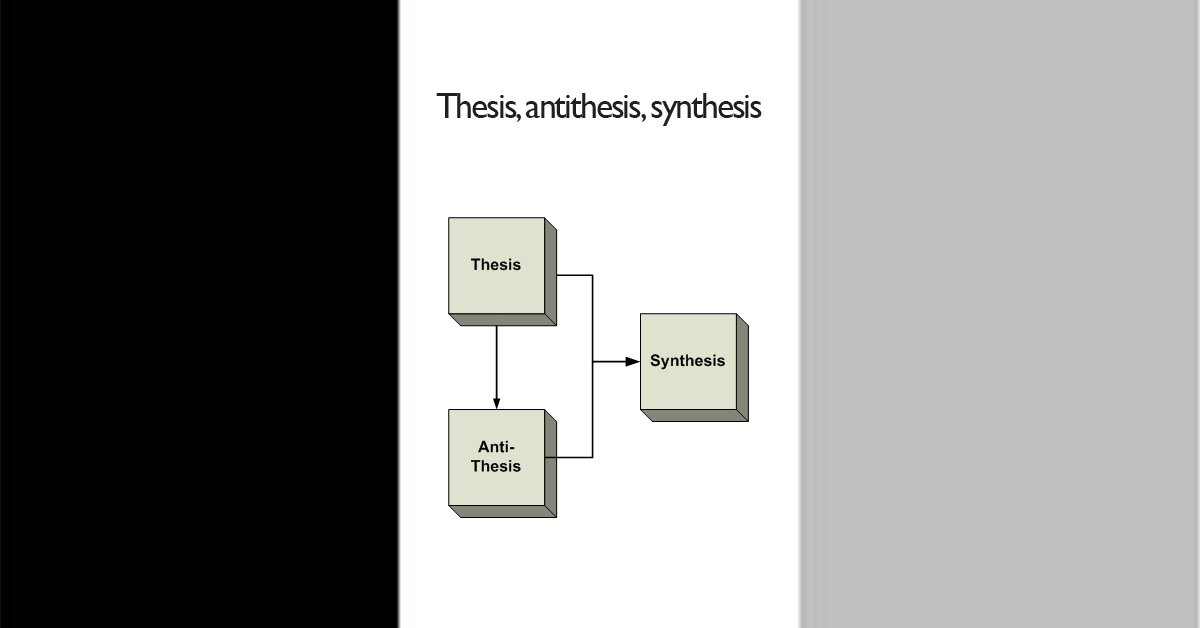Analysis and Synthesis Explained

Understanding Analysis and Synthesis
In simple terms, analysis examines a system by dividing a whole into its parts, and synthesis examines a system by combining and comparing parts.
In more complete terms, analysis is the top-down process of examining a rational or material system by analyzing its properties to better understand a system and its parts, and synthesis is the bottom-up process of examining the parts of systems and systems themselves, and comparing them to each other, to better understand systems whole, properties of systems, and their relations.[1][2][3]
Systems Theory: 1 Analysis and Synthesis.The origin of the terms analysis and synthesis: The terms analysis and synthesis come from classical Greek though and literally mean “to loosen up” and “to put together” respectively. Analysis is “to loosen up” to examine from the top down, from the system to its properties. Synthesis is to “to put together,” to examine from the bottom-up, to start with the pieces and see how they fit together. Both are simply different directions from which we can approach examining a rational or material (idea-based or real) system. See: Analysis and Synthesis On Scientific Method – Based on a Study by Bernhard Riemann for more reading after you check out the quick introduction to analysis and synthesis below.
Analysis and Synthesis Defined
To define the above in more complete terms:
A system is a collection of properties. It can either be simple, like a binary system, or complex, like the ecosystem of earth. With that said, a system as a whole and its properties can be rational (idea-based and “formal”), empirical (real and “material”), or mixed (for example, a computer contains rational properties like software and material properties like hardware). Thus, a system in this sense is simply any collection of real or imagined properties from a system of numbers, to an atom, to a collection of atoms as an object, to a collection of objects, to an essay, to the universe.
What is a Complex System?Analysis breaks down systems into this simplest parts in order to understand each individual part and the system as a whole.
What is Analysis?Synthesis compares the parts of one or more systems, or even whole systems themselves, in order to understand the relations between systems and parts of systems.
Synthesizing Information. Most of human reason involves synthesizing using an informal form of induction. Essentially, we notice something interesting and then compare it other ideas we have in our head to draw conclusions about what we observed and what it means in context.Analysis and Synthesis Explained in More Detail With Examples
To further illustrate Analysis and Synthesis, we can offer the following example.
Say we have 3 systems, let’s call them X, Y, and Z.
- Analysis would take each system and dissect that system to see what was true about each system respectively, defining the properties of X, Y, and Z, then defining the properties of those properties until no further analysis could be done.
- Synthesis on the other hand would look at each part of each system individually (from the most basic property to the most complex) to see how those parts related to other parts in the system, to see how those parts related to parts of the other systems, and to see how the systems related to each other. In doing this it would attempt to consider all possible relations, considering two given properties at a time, or considering two or more properties or systems together.
Since analysis deals with what is true about a system (as it examines what properties are contained in the system), it generally uses top-down deductive reasoning to understand what is certain about a system (unless we observed or measured the system incorrectly, what we glean from the system should have a degree of certainty to it; ex. we look at the black cat, we notice the property blackness, we can thus be fairly sure “the black cat is black.”).
Since synthesis deals with the relations between systems and properties of systems, it generally uses bottom-up inductive reasoning to see what is likely true about a property of a system or system of properties in terms of their relation to other systems and/or properties. Because it is comparing systems, and inferring relations based on a sort of reasoning by analogy, it can tend to produce insights that while valuable are less certain than those gleaned by analysis.
Both of these reasoning types, analysis and synthesis, can work in tandem or in isolation. After-all, to preform synthesis we must have first analyzed a system, and once we have preformed synthesis, we could very well uncover new aspects of a system to analyze.
In other words, analysis and synthesis are the two main directions from which we can approach studying any rational (idea-based and “formal”) or empirical (real and “material”) system.
Introduction to Complex Systems: Patterns in Nature.TIP: Another idea from Greek thought is Plato’s Dialectic and Aristotle’s Golden Mean. Learn how we can use analysis and synthesis to explore dualities. Or, learn about rationalism and empiricism and how we can apply analysis and synthesis to logic and reason. These concepts are at the heart of not only human reason, but well known systems like the scientific method. So there is a lot to learn about.
